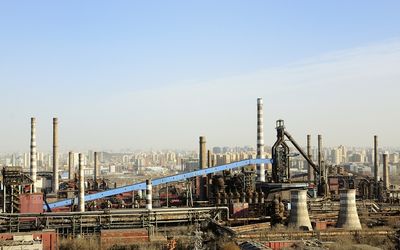OVER the past 35 years, China’s strong and sustained output growth — averaging more than 9.5% a year — has driven the miraculous transformation of a rural, command economy into a global economic superpower.
In fact, according to the World Bank’s most recent calculation of the purchasing power of aggregate income, China is about to overtake the US as the world’s largest economy. But, in the quality and sustainability of its growth model, China still has a long way to go. Despite its remarkable rise, China’s per capita income, at $10,057 (adjusted for purchasing power) in 2011, ranks 99th in the world — roughly a fifth of US per capita income of $49,782.
And reaching high-income status is no easy feat. Indeed, many countries have tried and failed, leaving them in a "middle-income trap", in which per capita income levels stagnate before crossing the high-income threshold.
Strong human capital is critical to enable China to escape this fate. But China’s labour force currently lacks the skills needed to support hi-tech, high-value industries. Changing this will require comprehensive education reform that expands and improves opportunities for children, while strengthening skills training for adults.
To be sure, over the past four decades the quality of China’s labour force has improved substantially, which is reflected in impressive gains in educational attainment. Gross enrolment rates at the primary level have reached 100% since the 1990s, while secondary and tertiary enrolment rates reached 87% and 24% respectively in 2012. In 2010, more than 70% of Chinese citizens aged 15-64 had received secondary education, compared to about 20% in 1970.
Further, Chinese pupils perform well in internationally comparable tests. Fifteen-year-olds in Shanghai outperformed pupils from 65 countries, including 34 Organisation for Economic Co-operation and Development countries, in mathematics, science and reading, according to the Programme for International Student Assessment in 2009 and 2012.
China has also benefited from rapid employment growth, with more than 7-million workers having entered the workforce each year since 1990. This, together with the reallocation of numerous workers from rural to urban areas, has supported the labour-intensive manufacturing industries that have fuelled China’s economic rise.
But China’s demographic advantage is diminishing quickly, owing to low fertility rates and population aging. According to the United Nations, by 2030, China’s working-age population (15–59 years old) will have decreased by 67-million from its 2010 level.
And, Chinese higher education leaves much to be desired, with employer surveys revealing that graduates of upper secondary schools and universities usually lack the required technical knowledge and soft skills. Last year, more than a third of Chinese firms surveyed said they struggled to recruit skilled workers, with 61% attributing this to a shortage of general employable skills. How, then, can China expect to achieve the export diversification and technological upgrading it needs to move up the global value chain?
Clearly, China needs to reform its higher-education institutions, including technical and vocational training programmes. At the same time, it must expand opportunities for anyone with talent to acquire high-quality secondary and tertiary education, thereby reducing substantial disparities in the accessibility and quality of higher education across regions and social groups. And the children of migrant workers in urban areas must be granted full access to the education system. Such efforts to reduce educational disparities would help to address income inequality — a significant threat to China’s future economic growth.
All of this will require increased public investment in education. As it stands, China’s public investment in education, as a share of gross domestic product, is below international standards across all levels, but especially in senior secondary and tertiary education.
China’s education challenge also extends to quality. Inadequate education is a major driver of rising unemployment among China’s senior secondary and tertiary graduates, not to mention their declining wage premium. This can be remedied through better financing, more effective recruitment and compensation policies, and more decentralised decision-making in school administrations.
Finally, though some evidence suggests there is an oversupply of university graduates in China, continuing demographic and sectoral shifts mean China will encounter a supply deficit of 24-million highly skilled graduates of universities or higher-level vocational schools by 2020. To fill this gap, China must upgrade its fragmented and ineffective technical-and vocational-training programmes.
To ensure its labour force can meet the demands of a rapidly changing economic and technological environment, China must build a more inclusive, higher quality education system. Without it, China may not be the world’s number one economy for long.
• Lee, professor of economics and director of the Asiatic Research Institute at Korea University, was an adviser for international economic affairs to former president Lee Myung-bak of South Korea.
© Project Syndicate 1995–2014

JOBS GROWTH: China has grown rapidly, with more than 7-million new workers finding work each year since 1990. Picture: THINKSTOCK
OVER the past 35 years, China’s strong and sustained output growth — averaging more than 9.5% a year — has driven the miraculous transformation of a rural, command economy into a global economic superpower.
In fact, according to the World Bank’s most recent calculation of the purchasing power of aggregate income, China is about to overtake the US as the world’s largest economy. But, in the quality and sustainability of its growth model, China still has a long way to go. Despite its remarkable rise, China’s per capita income, at $10,057 (adjusted for purchasing power) in 2011, ranks 99th in the world — roughly a fifth of US per capita income of $49,782.
And reaching high-income status is no easy feat. Indeed, many countries have tried and failed, leaving them in a "middle-income trap", in which per capita income levels stagnate before crossing the high-income threshold.
Strong human capital is critical to enable China to escape this fate. But China’s labour force currently lacks the skills needed to support hi-tech, high-value industries. Changing this will require comprehensive education reform that expands and improves opportunities for children, while strengthening skills training for adults.
To be sure, over the past four decades the quality of China’s labour force has improved substantially, which is reflected in impressive gains in educational attainment. Gross enrolment rates at the primary level have reached 100% since the 1990s, while secondary and tertiary enrolment rates reached 87% and 24% respectively in 2012. In 2010, more than 70% of Chinese citizens aged 15-64 had received secondary education, compared to about 20% in 1970.
Further, Chinese pupils perform well in internationally comparable tests. Fifteen-year-olds in Shanghai outperformed pupils from 65 countries, including 34 Organisation for Economic Co-operation and Development countries, in mathematics, science and reading, according to the Programme for International Student Assessment in 2009 and 2012.
China has also benefited from rapid employment growth, with more than 7-million workers having entered the workforce each year since 1990. This, together with the reallocation of numerous workers from rural to urban areas, has supported the labour-intensive manufacturing industries that have fuelled China’s economic rise.
But China’s demographic advantage is diminishing quickly, owing to low fertility rates and population aging. According to the United Nations, by 2030, China’s working-age population (15–59 years old) will have decreased by 67-million from its 2010 level.
And, Chinese higher education leaves much to be desired, with employer surveys revealing that graduates of upper secondary schools and universities usually lack the required technical knowledge and soft skills. Last year, more than a third of Chinese firms surveyed said they struggled to recruit skilled workers, with 61% attributing this to a shortage of general employable skills. How, then, can China expect to achieve the export diversification and technological upgrading it needs to move up the global value chain?
Clearly, China needs to reform its higher-education institutions, including technical and vocational training programmes. At the same time, it must expand opportunities for anyone with talent to acquire high-quality secondary and tertiary education, thereby reducing substantial disparities in the accessibility and quality of higher education across regions and social groups. And the children of migrant workers in urban areas must be granted full access to the education system. Such efforts to reduce educational disparities would help to address income inequality — a significant threat to China’s future economic growth.
All of this will require increased public investment in education. As it stands, China’s public investment in education, as a share of gross domestic product, is below international standards across all levels, but especially in senior secondary and tertiary education.
China’s education challenge also extends to quality. Inadequate education is a major driver of rising unemployment among China’s senior secondary and tertiary graduates, not to mention their declining wage premium. This can be remedied through better financing, more effective recruitment and compensation policies, and more decentralised decision-making in school administrations.
Finally, though some evidence suggests there is an oversupply of university graduates in China, continuing demographic and sectoral shifts mean China will encounter a supply deficit of 24-million highly skilled graduates of universities or higher-level vocational schools by 2020. To fill this gap, China must upgrade its fragmented and ineffective technical-and vocational-training programmes.
To ensure its labour force can meet the demands of a rapidly changing economic and technological environment, China must build a more inclusive, higher quality education system. Without it, China may not be the world’s number one economy for long.
• Lee, professor of economics and director of the Asiatic Research Institute at Korea University, was an adviser for international economic affairs to former president Lee Myung-bak of South Korea.
© Project Syndicate 1995–2014























Change: -0.47%
Change: -0.57%
Change: -1.76%
Change: -0.34%
Change: 0.02%
Data supplied by Profile Data
Change: -1.49%
Change: -0.04%
Change: -0.47%
Change: 0.00%
Change: 0.08%
Data supplied by Profile Data
Change: 0.16%
Change: 0.61%
Change: 0.12%
Change: -0.29%
Change: 0.82%
Data supplied by Profile Data
Change: 0.25%
Change: -0.42%
Change: 0.20%
Change: -1.57%
Change: -0.96%
Data supplied by Profile Data